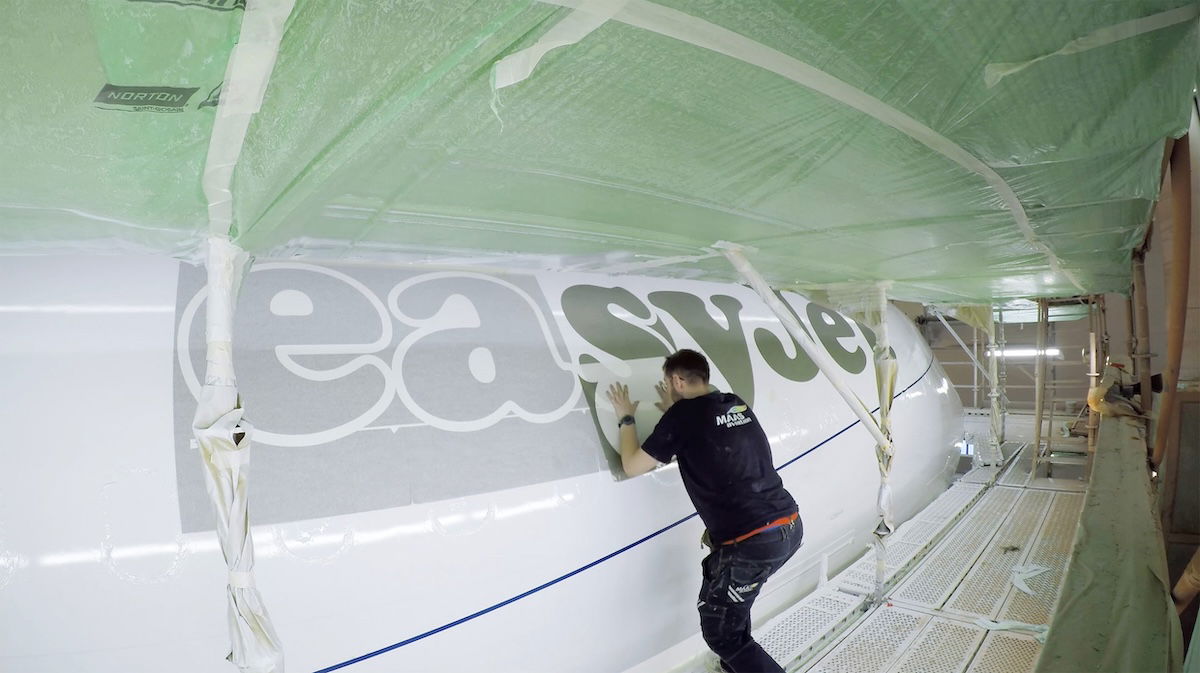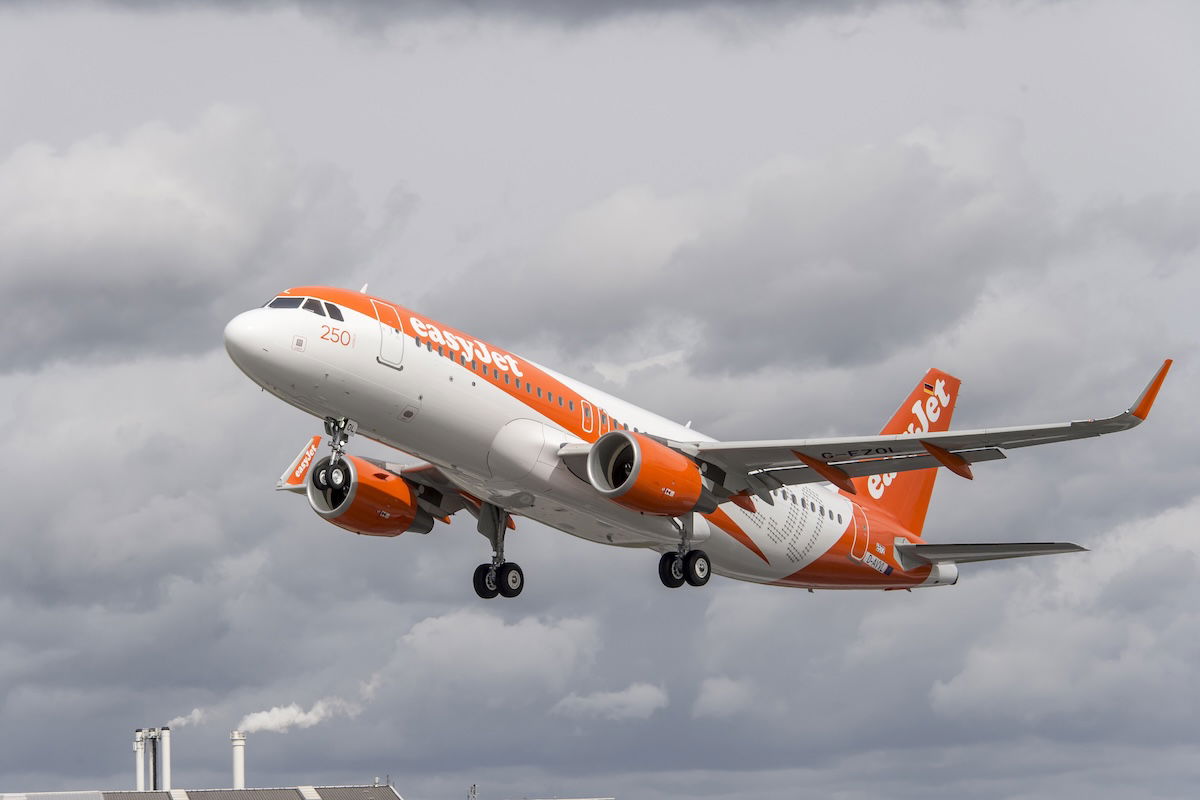Airlines are always looking for ways to lower their emissions, both to meet their climate goals, and also to reduce costs (after all, less fuel burn leads to savings). Along those lines, EasyJet has just introduced an interesting initiative, which shows how a little change can make a big collective difference…
In this post:
EasyJet hopes to reduce fuel burn by 1,296 tons per year
EasyJet is currently rolling out a lower-weight aircraft paint, in partnership with Mankiewicz Aviation Coatings, which is anticipated to eventually save up to 1,296 tons of fuel annually. 1,296 might not sound like a big number for an airline with hundreds of planes, but that’s 2,592,000 pounds of fuel, or roughly 381,000 gallons.
So far, the new paint has been applied to 38 EasyJet aircraft. The rollout is only happening gradually, as planes would naturally be repainted, so the project is expected to be completed by 2030. EasyJet is the first airline in the world to be introducing this new paint, and it’s one of many techniques the airline is using to reduce emissions.
The new system reduces the amount of paint needed to create the iconic EasyJet livery colors. Here’s how Lahiru Ranasinghe, the company’s Director of Sustainability, describes this:
“EasyJet is constantly exploring and developing innovative solutions to lower the impact of our operations. While this forms a small part of a bigger strategy, formulating a new lightweight paint with our partners at Mankiewicz Aviation Coatings exemplifies how we’re assessing every single part of our operation to find efficiency gains to help us achieve this mission.”


This “only” reduces weight by 27 kilograms per plane
Here’s what I find so interesting. 381,000 gallons of fuel per year is a pretty significant amount. So, how much is the weight actually being reduced with this paint change? Well, the new paint only leads to a weight reduction of 27 kilograms (roughly 60 pounds) per aircraft, so that really isn’t a whole lot.
For context, the maximum takeoff weight of an Airbus A320neo is around 79,000 kilograms (around 172,000 pounds), so we’re talking about a tiny fraction of a percent reduction in the overall weight of the aircraft.
But it shows you how small changes can make a big difference when applied across a large fleet. When you consider the cost of jet fuel, saving 381,000 gallons easily translates to roughly a million dollars in savings annually. Now, I’m not sure if painting aircraft with the lighter paint is cheaper (since less is needed) or more expensive (since it’s more advanced), but that’s the math on an ongoing basis, at least. Then again, the airline has over $7 billion in revenue annually, so $1 million is a tiny fraction of that.
It’s nice when the opportunity for incremental savings are considered when we’re talking about things like reducing emissions. However, I think we all know that airline executives often have similar logic with much of the passenger experience. Saving a few cents here and there on each passenger can translate to a lot of money across the system.
Bottom line
EasyJet is introducing a lighter paint for its aircraft. This will reduce the weight of each aircraft by 27 kilograms, and when rolled out across the fleet by 2030, it’s expected to lead to a reduction in fuel burn of 1,296 tons per year. That’s a lot of fuel in absolute terms, though a tiny fraction of what the airline consumes.
What do you make of EasyJet’s lighter paint initiative?





Meanwhile, Lufthansa Group adds a 1000+ KG weight to their Swiss A330's because their new first class is also heavier.
Sounds like a nothing burger to me?
Total greenwashing… They created a PR moment about almost nothing.
At least they're keeping the Cooper Black font!
Cost of PR for this greenwash already exceed the life time savings and environmental impact.
Let's burn even more energy to tell the world we're saving a little energy.
AA for the longest time had planes unpainted to save on fuel. But that isn’t possible with the new composite material planes.
But it cost them more to polish the metal.
Why don't the cargo planes start using engine heat to heat the cargo hold. We all know hot air is lighter than cold air. If new paint saves money for a 60 pound difference, what will a hot cargo hold in a cold high altitude do? Apparently silly ideas are now being funded.
"EasyJet Rolling Out Lighter Paint To Get Nice Stories Written About Them"
ftfy
I wonder what “fat tax” America is paying for flying around at a 43% obesity percentage. Especially compared to Japan that is 4%.
Some quick AI number crunching shows 4-6 BILLION gallons would be saved for the big three alone if passengers were average Japanese weight as opposed to American weight. Flights could be incredibly cheaper, or alternatively, profit margins would 3-5x. Wild.
Hope everyone does well with their New Years fitness goals.
I was dubious of that number, but got a similar value. The average American is about 10kg overweight and ~800B passenger miles are flown. The marginal fuel use per kg mile is ~0.002kg. 10 x 800B x 0.002 = 16B kg of additional fuel or ~4 billion gallons.
Yeah keep in mind this only half the market. For the entire United States could be pushing 8-12 billion gallons.
No doubt North America has an obesity problem, but at average weight, the savings would be maybe half that, since the average American is also taller than the average Japanese (and hence heavier even at same BMI and body fat %).
There’s one country you didn’t factor, the only one with a higher obesity rate.
Anyways, that’s trivia.
Let’s talk real life / real savings…
A very racist comment.
I'm surprised no one called you out.
Racism against the white is tolerated completely in OMAAT.
Maybe US airlines should lobby against the processed food industry as a way to improve their profitability.
Just, no. Cannot take this seriously until a full, truthful description is made of the repainting process, including all chemicals used, their origins, how far they were transported, by what means, the whole carbon footprint of the repainting exercise. Then, a full explanation on the rationale for repainting the plane now instead of later, or not at all. Also let's please disclose the projected lifespan of the lighter coating, compared to the previous type. American...
Just, no. Cannot take this seriously until a full, truthful description is made of the repainting process, including all chemicals used, their origins, how far they were transported, by what means, the whole carbon footprint of the repainting exercise. Then, a full explanation on the rationale for repainting the plane now instead of later, or not at all. Also let's please disclose the projected lifespan of the lighter coating, compared to the previous type. American used to leave bare metal over much of the fuselage; now they paint the entire plane. Discuss? The actual content of the new coating is only a small factor in the carbon footprint of the repainting exercise. Let's be skeptical about these kinds of greenwashing PR exercises.
100% agree with you.
@DenB I agree with you on the whole re ‘PR greenwashing’, but a few things in your comment stand out.
-easyJet itself says it is trialing new paint as aircraft would normally be scheduled for repainting, so they aren’t repainting planes “now” instead of later. Aircraft are typically repainted during D checks which occur every 5-8 years depending on aircraft cycles and hours. That jives with their expectation of this taking to 2030. I would...
@DenB I agree with you on the whole re ‘PR greenwashing’, but a few things in your comment stand out.
-easyJet itself says it is trialing new paint as aircraft would normally be scheduled for repainting, so they aren’t repainting planes “now” instead of later. Aircraft are typically repainted during D checks which occur every 5-8 years depending on aircraft cycles and hours. That jives with their expectation of this taking to 2030. I would imagine if it becomes apparent sometime between now and then that the new paint sucks for whatever reason, they’ll stop.
-American changed their livery in part due to the increasing quantity of carbon composites in aircraft parts. If they wanted to keep the silver exteriors, they would have had to paint the entire aircraft silver. Shiny paint has a lot of metallic flecks in it, and it shouldn’t come as a surprise to anyone that metallic flakes are heavy.. Thats a driving reason only the engine cowls of Virgin America (RIP) aircraft had the super-sparkly red paint, while the tails were painted a more flat red and the bodies white.